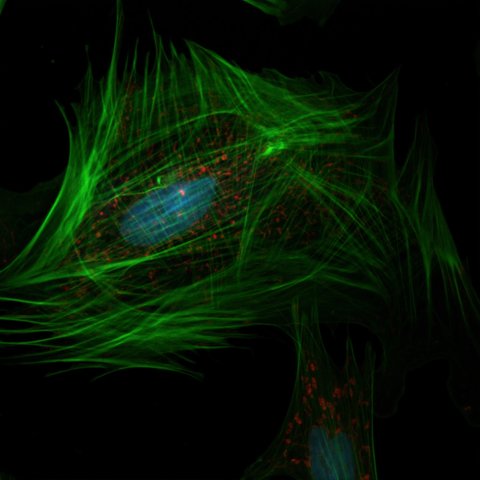Delft research
As early as 2019, Delft researchers gave the field of super-resolution microscopy a major step forward by improving the precision of the technique by about a factor of two (see here† Now they come up with a scientific paper that highlights the fundamental limitations of components of super-resolution microscopy. “And we also offer a calculation method for other researchers to make more carefully considered choices,” says the Delft PhD student and first author of the publication Dylan Kalisvaart.
The researchers led by Carlas Smith are reviewing the foundations for the super-resolution method called Iterative Single-Molecule Localization Microscopy. They use illumination patterns to zoom in on individual molecules. They use results from previous experiments to move the patterns closer and closer to molecules. This makes it possible to increase the sharpness of the image, precisely in the places where molecules are located.
Kalisvaart, researcher at the Delft Center for Systems and Control, explains: “We show (with the so-called Van Trees inequality) that resolution improvement can be attributed to prior knowledge obtained from previous experiments. With this we show how, given the circumstances and the prior knowledge, the practical settings of a microscope should be in order to achieve the best result.”
–
Super-resolution microscopy
Super-resolution microscopy is a groundbreaking technology that allows researchers to look inside living cells. The technique uses luminescent proteins that can be found in jellyfish, for example. In 2008, three top researchers were awarded the Nobel Prize in Chemistry for discovering and developing this light-emitting protein, called GFP (Green Fluorescent Protein). Researchers can attach these fluorescent proteins to molecules using gene editing. When you illuminate such a protein with a laser, it then emits a small amount of light.
With the super-resolution method Single Molecule Localization Microscopy (SMLM), molecules are randomly switched on or off. Sensitive sensors make a video of the light signals, after which researchers analyze the data obtained. This allows them to determine the location of the molecules very precisely and to make a reconstruction of the cell structure. With an ordinary optical microscope you can make images on a scale of about half a micron. With super-resolution microscopy you can do that ten times better.
–
Development of super-resolution microscopy
The field of super-resolution microscopy has developed rapidly over the past decade. In 2014, three other researchers received the Nobel Prize in Chemistry for what became known as “super-resolution microscopy.” One of the three winners was German researcher Stefan Hell. Researchers at Hell’s lab stated in 2020 that Iterative Single-Molecule Localization Microscopy would improve resolution much further. The TU Delft scientists show that these large resolution improvements are virtually unattainable in practice.
Kalisvaart: “In practical circumstances you can at most get an improvement of about five times compared to the standard technique. The field largely assumed that the potential was much greater. We have now looked at this problem for the first time through a different mathematical (Bayesian) approach and show that the resolution improvements of Hell’s group are difficult to achieve in practice.”
Will the publication be Biophysical Journal now mainly see it as a setback? “I look at it very differently,” says Carlas Smith, Kalisvaart’s supervisor. “It is essential that the underlying science is solid. If the whole structure is not good, you have to go back to the ground floor to lay the foundation again.”
–


